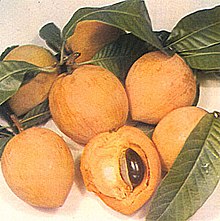Pouteria campechiana
| Canistel | |
|---|---|

| |
| Scientific classification | |
| Kingdom: | |
| (unranked): | |
| (unranked): | |
| (unranked): | |
| Order: | |
| Family: | |
| Genus: | |
| Species: | P. campechiana
|
| Binomial name | |
| Pouteria campechiana | |
| Synonyms | |
|
Knuth | |
The Canistel (Pouteria campechiana) is an evergreen tree native to southern Mexico and Central America.[1] It is cultivated in other countries, such as Brazil, Taiwan, and Vietnam. Its binomial name is derived from the Mexican town of Campeche, where it is native. It is sometimes (wrongly) referred to as Lucuma campechiana.
The canistel grows up to Template:M to ft high, and produces orange-yellow fruits, up to Template:Cm to in long, which are edible raw. Canistel flesh is sweet, with a texture often compared to that of a cooked egg yolk, hence its colloquial name of "eggfruit." It is closely related to the Mamey sapote and abiu.
Etymology
The plant's name in the Vietnamese language is cây trứng gà (“chicken egg” plant) because of the fruit's appearance. It also has the Vietnamese name lekima. This is very unusual because Vietnamese is a tonal language which uses predominantly monosyllabic words. It appears that this name derives from the word lucuma. The unusual name "Lekima" has been included in the list of typhoon names, and was applied to a storm that devastated north-central Vietnam and killed from 42 to 55 people in Vietnam on 10-03-2007.
References and links
- ^ "Pouteria campechiana". Germplasm Resources Information Network. United States Department of Agriculture. Retrieved 2009-01-29.
